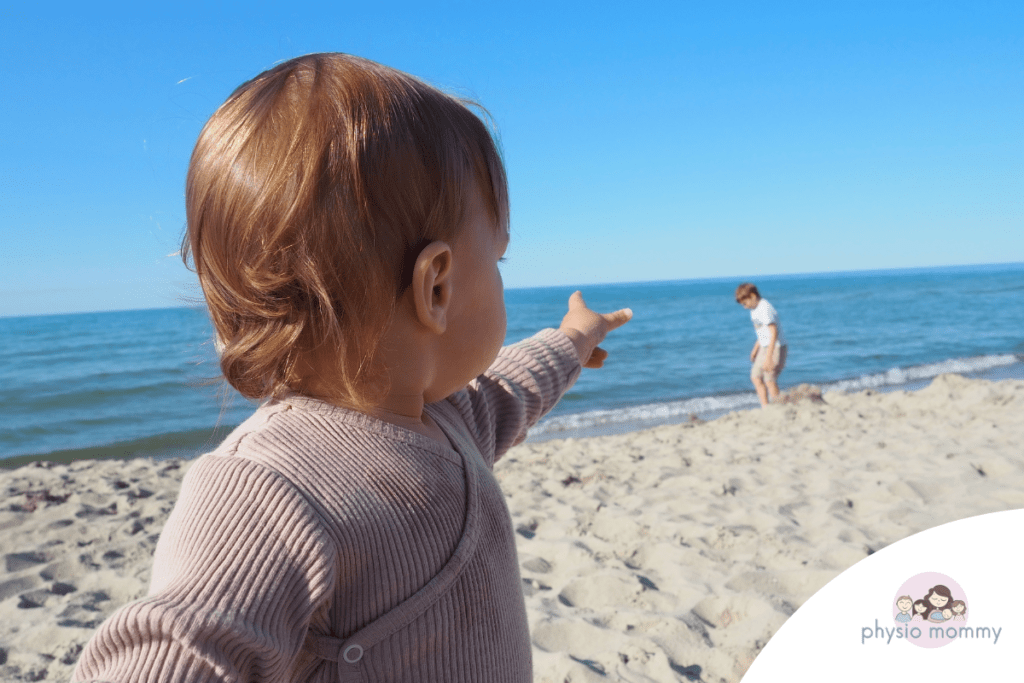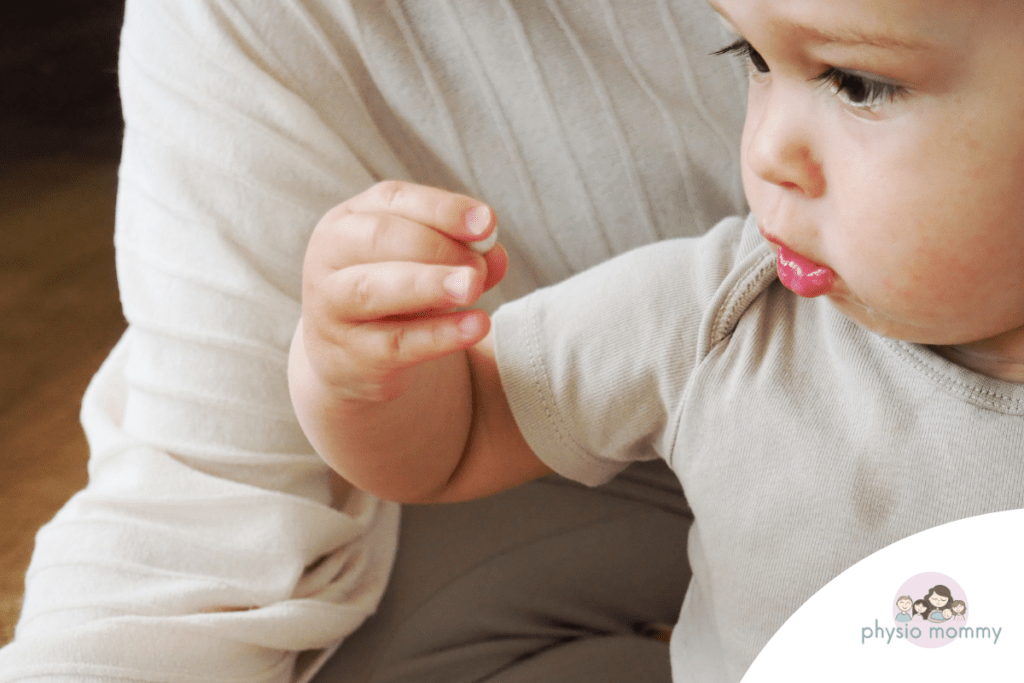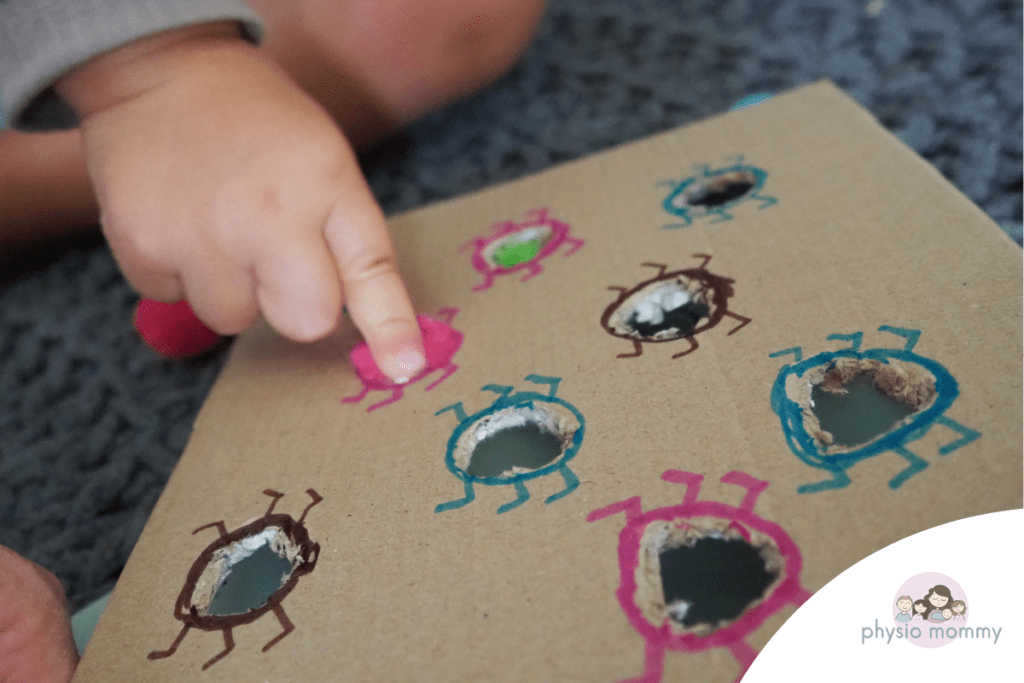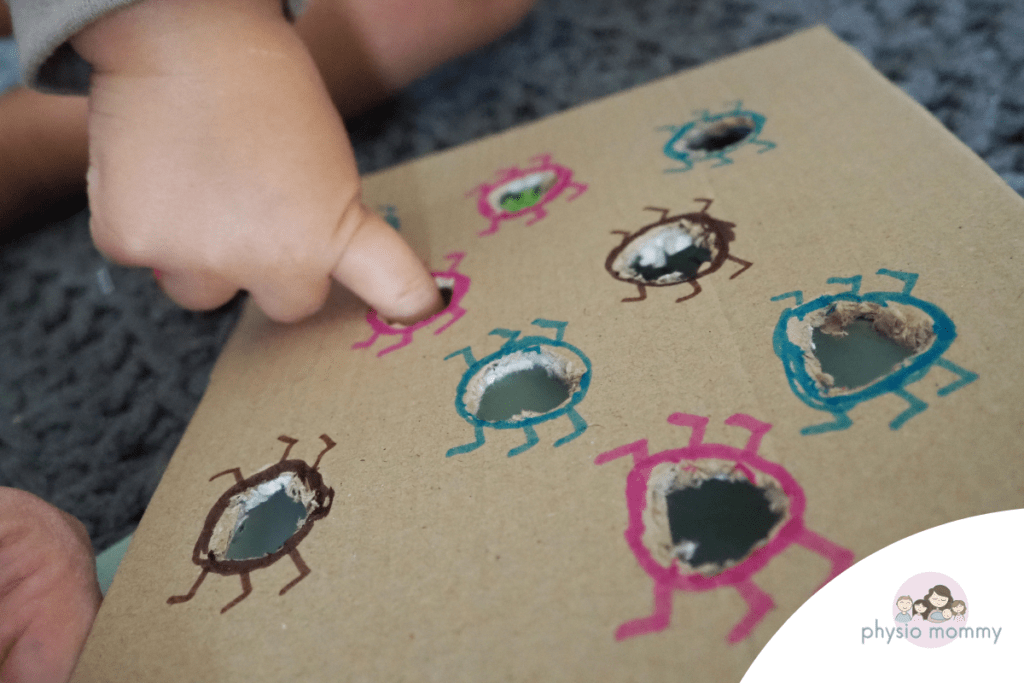The skill of pointing a finger is a very important part of child development, so it doesn’t surprise me that many parents look forward to the moment when it appears.
In this post, I want to touch on one more significant topic that we sometimes forget about, focusing so much on the “technical” side of this gesture.
FROM THIS ENTRY, YOU WILL LEARN:
- what the finger-pointing gesture is and when it should appear,
- what it is for and how it changes over time,
- what to pay attention to when you want to support the development of this gesture,
- what situation can be a warning sign and when to consult a specialist.
The first and most important thing that should be voiced clearly here is that the finger-pointing gesture cannot and should not be considered solely as a motor skill.
It is vital, of course, but if we were to approach it only in that sense, we wouldn’t get the whole picture.
The finger-pointing gesture is strongly related to the child’s ability to build a common field of attention – and this, in turn, is the foundation of communication.

To put it simply: our child, by pointing their finger, wants to tell us something. He or she can’t use words yet, because it’s too early for that, but is beginning to understand that they can communicate with the world through gestures.
One gesture, many meanings.
Initially, finger pointing is aimed at achieving a specific goal. For example, when pointing at an object, the child says: “Give me that, I want it!” (around 9th month of life). But that’s not all. The child, by pointing their finger, can also ask questions like: “Who is this?” or “What is this?” – It’s good to answer them then! 😉
Pointing the finger can also be an answer in itself. For instance, when the parent, reading a book about tractors with the child, asks the little one: “Where is the wheel?”, the child “answers” by pointing their finger at it.
Eventually, the finger-pointing gesture can be used to capture the parent’s attention and comment on reality (usually around 12th or 13th month). When the child notices an airplane flying, they point their finger at it, then look at the parent to see if he or she has understood the message and then turn their gaze back to the plane.
Over time, as the toddler becomes more adept at verbal communication, the finger-pointing gesture becomes an additional help, and next is replaced by words.
But until then, it is incredibly important for communication.

The development of the finger-pointing gesture is also related to the development of the grasp and manual dexterity of hands.
Now, let’s talk about the above-mentioned communication for a moment – why is it important that it develops at all?
It happens rather spontaneously and we often do things that support it completely intuitively, but despite all this, it is worth realizing that communicating with the parent must simply “pay off” for the child. 🙂
So, let’s look at it from the child’s perspective.
I am 10 months old. I want my mom to hand me the ball, which is right next to me but still out of my reach. I’m gradually realizing that if I point at it with my finger and make a few sounds, there’s a good chance I’ll get it.
If my mom responds and gives the ball to me, I will reinforce this pointing skill because I know that it will help me achieve my goals in the future.
Wow, this pointing gesture is really cool! Let’s go even further!
Over time, I’m discovering that pointing at objects can be used not only as a way to get them, but also to get some information about them or… capture my parent’s attention.
I like this gesture because it is so natural. I also like it because when mom reads me books and shows me different objects, I can turn her attention to something I particularly enjoy.
Now, let’s think about situations when the skill of pointing a finger may not have a chance to develop properly…
Let’s take a closer look at experiences.
When a parent ignores or, on the contrary, gives the child everything they can possibly think of before the little one can even point at anything, the value of communication begins to blur.
What’s the point of showing that I want this ball if I’m never going to get it because mom or dad are staring at their phones?
And on the other hand: Why show that I want the ball if I receive it before such a thought can even come to my mind?
I know we all want the best for our children, but really, we don’t have to entertain them all the time.😉 We can just sit back and let the child take the reins… We can just listen to them… I’m sure that then we will discover really amazing things!
When else might a little one have difficulty with pointing their finger?
For example, when their fine motor skills don’t “let” them.
If their motor skills are delayed in some way and the dexterity of their hands is not the best either, then we can’t expect the child to point at objects without any trouble.
The difficulty with such activity may occur in children with problems concerning muscle tension, tensed-up shoulders, clenching fists or assuming and moving around in the four-legged position (the four-legged position helps to straighten out fingers, supports the formation of the hand arches and helps to achieve dynamic stability in the shoulder area).
The development of motor skills is significant here.
What worries parents most is that the absence of the finger-pointing gesture or its severely limited extent (e.g. the child points at objects but completely fails to make eye contact and communicate with another person) may be one of the early signals of Autism Spectrum Disorders.
Such a situation is certainly worth consulting with a specialist, although while you’re waiting for an appointment, it’s also a good idea to turn off all devices with screens, which the little one is exposed to during the day – even those that are somewhere “in the background” and seemingly have no effect on the toddler. Instead, it’s better to just sit next to the child, tell them about what they are looking at at the moment and listen to them. It really does make a difference.
How to support the development of the finger-pointing gesture?
First of all, set a good example. 😊 When reading books or talking about something, point to the different elements in the picture. After all, children learn by imitation.


Do not focus only on the pointing gesture, but rather pay attention to whether the child builds a field of common attention as well. If he or she does so, then even if they still point with their whole hand instead of one finger (of course, isolating their index finger would still require some work), their visible willingness to communicate is already a lot.
We can help such toddlers by introducing them to various types of finger plays: touching one finger against the other, massaging, brushing the fingers… In order for the child to use their index finger, they must first “feel” it well, realize that it’s there, notice it and acquire all the motor skills necessary for isolating it from the others.
Once we take care of sensory and motor stimulation, we can focus on cognitive function (i.e. reading books and pointing the finger at different elements of pictures, asking “where is it?”, etc).
Finally, we can move on to language stimulation – pointing to an object or a person, asking the child: “Who is it?”, “What is it?”…
Many of these things we really do in an intuitive way.
Now, I’m giving you a recipe for homemade cinnamon cookie dough, which is a great sensory challenge for little hands.
The recipe was found somewhere on the Internet.
Remember to be by your toddler’s side while playing, as the dough is not edible.
- 2 tablespoons of oil or olive oil,
- 1 tablespoon of citric acid
Mix it, heat until it thickens and then add cinnamon.
Enjoy!
To sum up:
- Pointing a finger is an important part of development, but not only as an isolated motor activity, but rather a way of communication related to the ability to build a common field of attention.
- Most often, the finger-pointing gesture appears around the age of 9 months, evolves and then is replaced by words.
- In addition to the finger-pointing gesture, it is also important that the child makes eye contact and is willing to interact with their parent – it is a sign of engagement and understanding of reality.
- It is essential to reinforce these abilities in the child: respond to what he or she is trying to tell us, but also maintain a healthy balance and leave space for the child to express themselves. Listen to them carefully! 🙂
- Language, cognitive, motor and social development – it all goes hand in hand!
- The lack of finger-pointing gesture after the age of 12 months is an indication for consultation. Don’t be afraid of it! It’s better to have one too many appointments than one too few.
- Caring for the development of communication, turn off all devices with screens.
The content herein is for informational purposes only and will not replace a visit to a physiotherapist or other specialist. If in doubt, please consult with a professional who can examine your baby in person. For the sake of your baby, I do not provide online advice.
For great ideas for spending time and playing with your baby, check out my E-book:
Sources:
- Iverson J.M., Goldin-Meadow S., 2005, Gesture paves the way for language development, „Psychological Science”, vol. 16 (5), s. 367–371.
- Siudak, A. & Bielenda-Mazur, E. (2020). Neurorozwojowy wymiar gestu wskazywania palcem – rozwój i stymulacja. Logopaedica Lodziensia, (4), 171–186. https://doi.org/10.18778/2544-7238.04.12.
Sharing my content with your friends would mean the world to me. Thank you! ❤️